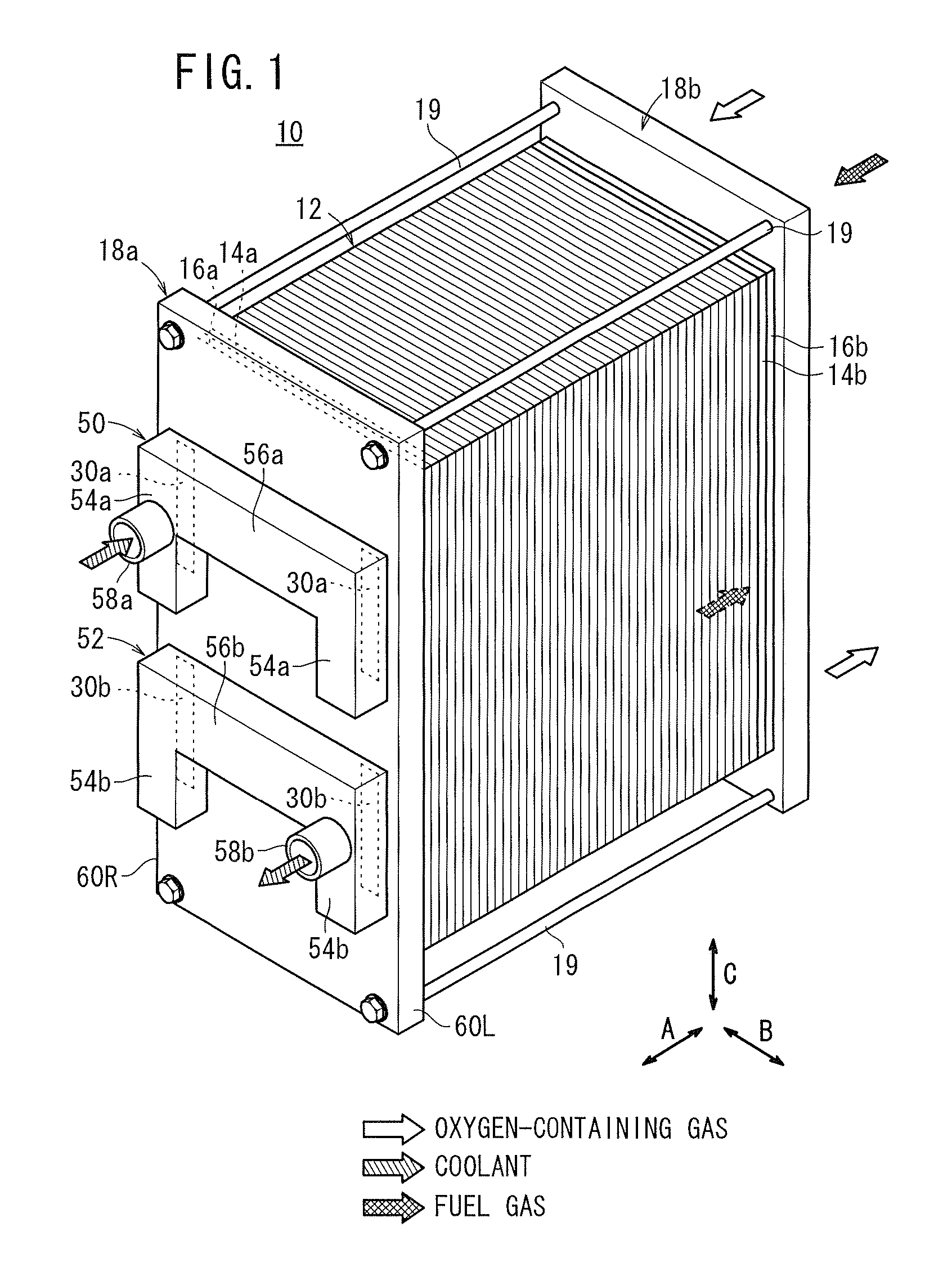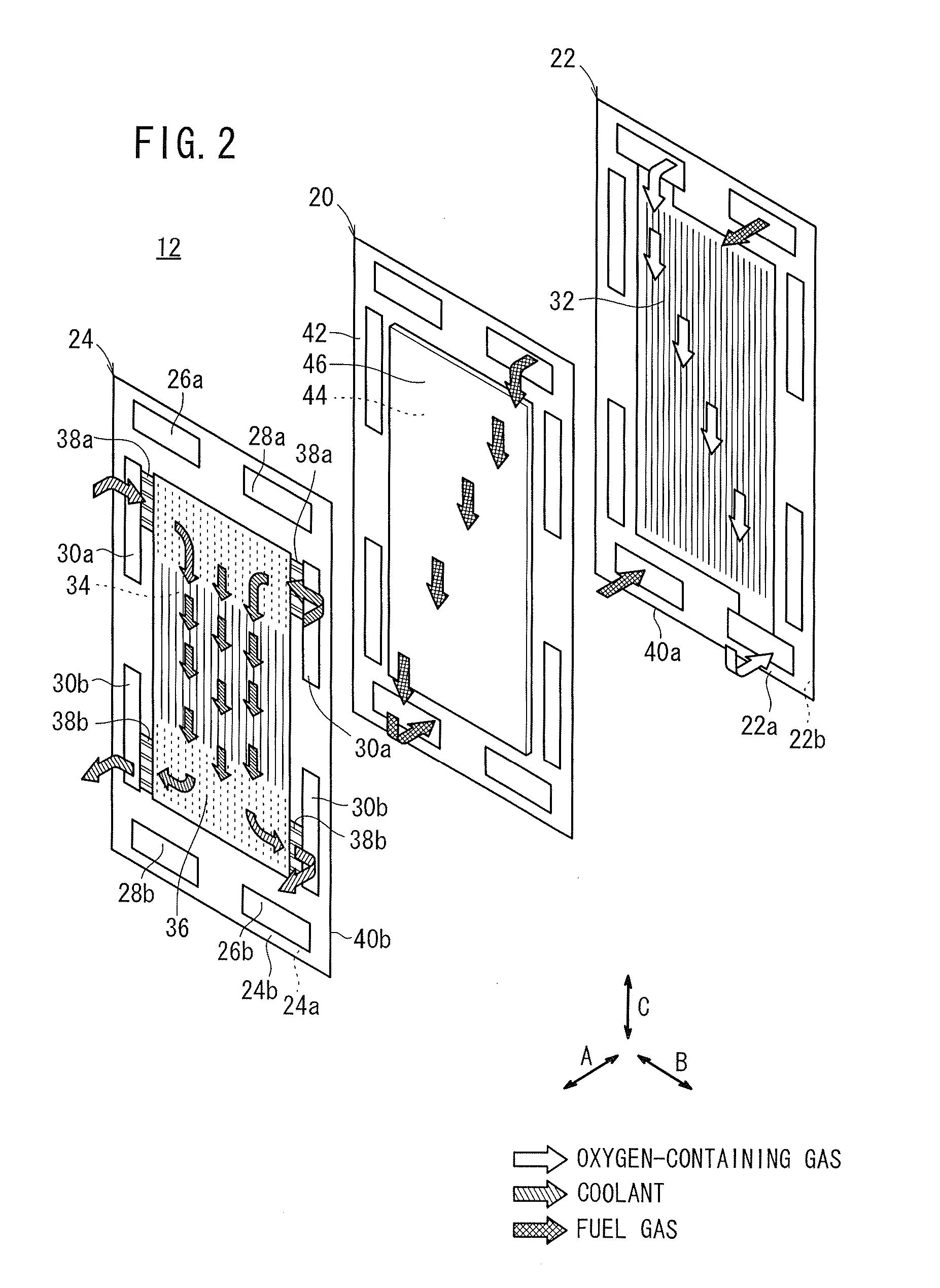Fuel cell stack
a technology of fuel cell stack and stacking, which is applied in the direction of fuel cells, cell components, fuel cell grouping, etc., can solve the problems of difficult to allocate the same flow rate of coolant to the pair of left and right holes, the pressure loss in the manifold is reduced, and the cooling effect is simple and uniform
- Summary
- Abstract
- Description
- Claims
- Application Information
AI Technical Summary
Benefits of technology
Problems solved by technology
Method used
Image
Examples
first embodiment
[0034]As shown in FIG. 1, a fuel cell stack 10 according to the present invention is formed by stacking fuel cells 12 in a horizontal direction indicated by an arrow A or in a vertical direction indicated by an arrow C.
[0035]A first terminal plate 14a, a first insulating plate 16a, and a first end plate 18a are stacked on one end of the fuel cells 12 in the stacking direction. Further, a second terminal plate 14b, a second insulating plate 16b, and a second end plate 18b are stacked on the other end of the fuel cells 12 in the stacking direction.
[0036]Components between the first end plate 18a and the second end plate 18b each having a rectangular shape are tightened together by a plurality of tie-rods 19 extending in the direction indicated by the arrow A. Alternatively, components of the fuel cell stack 10 are held together by a box-shaped casing (not shown) including the first end plate 18a and the second end plate 18b.
[0037]As shown in FIG. 2, the fuel cell 12 is formed by stac...
second embodiment
[0074]FIG. 8 is a perspective view with partial omission of a fuel cell stack 70 according to the present invention.
[0075]The constituent elements that are identical to those of the fuel cell stack 10 according to the first embodiment are labeled with the same reference numerals, and detailed descriptions thereof will be omitted. Also, in third or further embodiments described later, the constituent elements that are identical to those of the fuel cell stack 10 according to the first embodiment are labeled with the same reference numerals, and detailed descriptions thereof will be omitted.
[0076]The fuel cell stack 70 includes a coolant supply manifold 72 and a coolant discharge manifold 74 provided on the outer surface of the first end plate 18a. Each of the coolant supply manifold 72 and the coolant discharge manifold 74 has substantially an H-shape.
[0077]The coolant supply manifold 72 includes a pair of longitudinally elongated supply manifold sections 76a and a supply coupling se...
third embodiment
[0081]FIG. 9 is a perspective view with partial omission of a fuel cell stack 90 according to the present invention.
[0082]The fuel cell stack 90 includes a coolant supply manifold 92 and a coolant discharge manifold 94 provided on the other surface of the first end plate 18a. Each of the coolant supply manifold 92 and the coolant discharge manifold 94 has a substantially U-shape which is opened upward.
[0083]The coolant supply manifold 92 includes a pair of longitudinally elongated supply manifold sections 96a and a supply coupling section 98a coupling lower portions of the pair of supply manifold sections 96a together. The pair of supply manifold sections 96a are connected to the pair of coolant supply passages 30a. The width of the supply coupling section 98a (along the long sides in the longitudinal direction indicated by the arrow C) is smaller than the width of the pair of supply manifold sections 96a (along the long sides in the longitudinal direction indicated by the arrow C)....
PUM
| Property | Measurement | Unit |
|---|---|---|
| width | aaaaa | aaaaa |
| area | aaaaa | aaaaa |
| internal volume | aaaaa | aaaaa |
Abstract
Description
Claims
Application Information
 Login to View More
Login to View More - R&D
- Intellectual Property
- Life Sciences
- Materials
- Tech Scout
- Unparalleled Data Quality
- Higher Quality Content
- 60% Fewer Hallucinations
Browse by: Latest US Patents, China's latest patents, Technical Efficacy Thesaurus, Application Domain, Technology Topic, Popular Technical Reports.
© 2025 PatSnap. All rights reserved.Legal|Privacy policy|Modern Slavery Act Transparency Statement|Sitemap|About US| Contact US: help@patsnap.com



